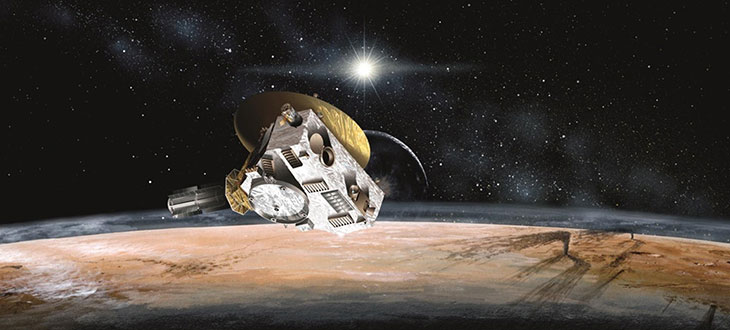Giant Mission To A Dwarf Planet

NASA
(Inside Science) -- It isn't new, and it doesn't even qualify as a full-fledged planet. But Pluto, the dwarf planet in the depths of our solar system, is creating the brand of excitement among modern astronomers that English poet John Keats characterized two centuries ago:
Then felt I like some watcher of the skies/When a new planet swims into his ken.
The reason for this enthusiasm: Pluto is about to receive a visit from a spacecraft. In mid-July, after a journey of almost 1.5 billion miles over nine and a half years, the grand-piano-sized craft will fly within about 6,000 miles of the dwarf planet.
New pictures
The mission, titled New Horizons, will give astronomers their first close-up views of Pluto and its five known moons – views far superior to those obtained by previous observations.
The craft carries what principal investigator Alan Stern of the Southwest Research Institute in Boulder, Colorado calls "the most powerful suite of instrumentation ever brought to bear on reconnaissance of a planet." The instruments have already obtained intriguing glimpses of surface markings. These suggest the possibility that Pluto has a polar ice cap similar to those on Mars and our own planet Earth.
"We're seeing real features on the surface of Pluto for the first time," Stern said.
"We are entering an entirely new realm of the solar system," added John Grunsfeld, associate administrator for NASA's science mission directorate at a briefing on the mission.
"Astronomers, including myself and some who didn't use to be interested in Pluto, have been planning their lives and research around the mission, wanting to capture data at this critical time," said Marc Buie of the Southwest Research Institute.
Jay Pasachoff, chair of astronomy at Williams College in Williamstown, Massachusetts, outlined the extent of the New Horizons mission's task.
"Pluto is much less well characterized than any of the regular planets and a dozen or so of the asteroids," he said. "All we know about it is a few blotches a few pixels across."
Nevertheless, those blotches have given astronomers a much better feel for the Pluto system than they had of other distant objects before spacecraft visited them.
That knowledge includes reasonably precise ideas of Pluto's size, mass, and density and a solid understanding of the very different atmospheres of Pluto and its main moon Charon. Astronomers have also detected an unexpected episode of Plutonian global warming.
NASA Animation of New Horizons Mission
What we know about Pluto
Almost as soon as Clyde Tombaugh discovered Pluto in 1930 beyond the orbit of Neptune, then the furthest known planet from the sun, astronomers realized that it was a strange beast.
"Regardless of what you call it, Pluto is a fascinating object, said Gareth Williams, associate director of the Smithsonian Astrophysical Observatory's Minor Planet Center in Cambridge, Massachusetts.
Much tinier than the four massive planets between it and Mars, Pluto seems to lie on its side, with one pole always facing the sun. It has a highly eccentric orbit that takes it between 30 and 50 times further from the sun than our Earth. Between 1979 and 1999, Pluto moved inside Neptune's orbit.
Pluto's minuscule size, combined with the discovery of "trans-Neptunian objects" of similar size, persuaded the International Astronomical Union in 2006 to make the controversial move of recategorizing it as a dwarf planet rather than a planet in its own right.
Traditionalists continue to criticize proponents of the change, such as astrophysicist Neil deGrasse Tyson, director of New York City’s Hayden Planetarium. But astronomers have largely accepted the change.
"Pluto is the best and the brightest of the dwarf planets," said Pasachoff, who had voted against the change but now agrees with it.
The recent understanding of Pluto has emerged from a series of sophisticated scientific techniques.
Old school physics applied to Pluto
Its moon Charon, discovered in 1978, enabled the first determination of Pluto's mass. Since Charon is about one-eighth as massive as Pluto, a much greater ratio of moon to planet than anywhere else in the solar system, it exerts a strong gravitational pull on Pluto.
Applying a formulation originally developed by Isaac Newton to the gravitational force between the two objects, Pasachoff said, "astronomers realized that Pluto has only one-five hundredth of the mass of Earth, not 90 percent as previously thought." Seven satellites in the solar system, including our own Moon, have more mass than that.
The gravitational approach also permitted planetary scientists to estimate Pluto's diameter at about 1,471 miles, plus or minus five miles. That makes it about two-thirds as wide as the Moon.
In 1985, the technique of occultation, in which astronomers monitor a planet as it passes in front of a star, indicated that Pluto has an atmosphere. Charon has one, too.
New technologies, new questions
To determine the composition of the two objects' atmospheres, scientists have turned to infrared spectroscopy. Infrared views taken with telescopes atop the Mauna Kea volcano in Hawaii have revealed that Pluto's and Charon's atmospheres differ considerably.
"We've known since the 1990s that water ice dominates Charon while nitrogen, methane, and carbon monoxide ice dominate Pluto," Buie noted.
The difference, combined with the fact that the two bodies have different densities, poses an intriguing question for the New Horizons team: What has caused the differences?
The most recent source of information comes from the Hubble Space Telescope, which offers seven times finer resolution than the typical ground-based instrument. Using the Hubble and a mathematical process called deconvolution helped scientists identify markings on Pluto's surface.
"Deconvolution transforms a blob into a true representation of Pluto," said Hal Weaver, a New Horizons project scientist at the Johns Hopkins Applied Physics Laboratory in Laurel, Maryland.
Images taken by Hubble enabled Buie and colleagues to discover the tiny moons Nix and Hydra about 28 and 38 miles in diameter respectively, in 2005. Hubble images revealed the even smaller satellites Kerberos and Styx in 2011 and 2012.
At one point, the astronomical community worried that Pluto's atmosphere would literally freeze before the New Horizons craft arrived, as the dwarf planet moved further from the sun.
"But our work since 2002 has shown that the atmosphere has been warming," Pasachoff said. The apparent reason: A thermal lag similar to that which causes Earth's atmosphere typically to be warmer at 4 p.m. than at noon, even though the sun is lower then.
As the New Horizons craft approaches ever closer to its target, astronomers around the globe are preparing their own observations of Pluto, to complement the mission's findings.
"I just want to see great pictures," Williams said. "As a human being rather than an astronomer, I want to see images of the surface – to look at the craters, canyons and mountains, and realize that until recently it was just an interesting blob in the telescope."

